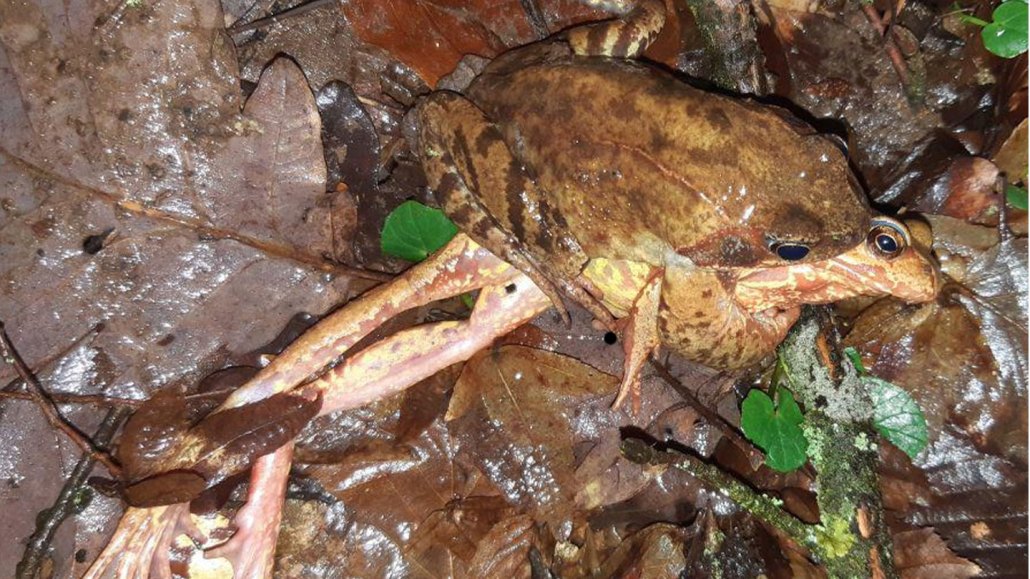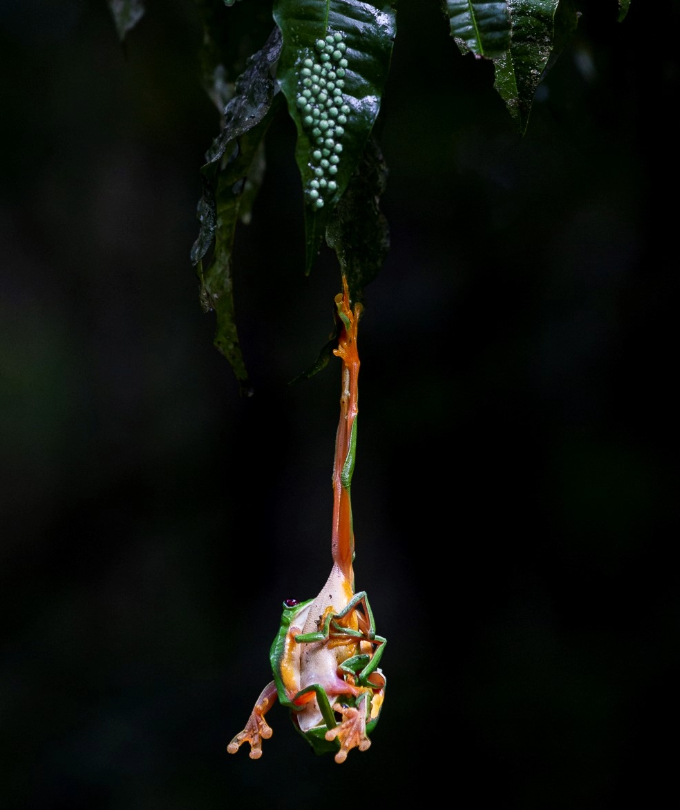
The “dead” female frog in this male’s mating embrace is only temporarily immobile. Looking dead is one way female European common frogs escape hyper-grabby males.
Carolin Dittrich
Grab fast and hang on for hours. A fierce grip is all the courtship finesse a male frog needs in species that reproduce in frenzied mobs.
Female European common frogs, however, have at least three moves that give them a chance of escaping overbearing male grasps, say evolutionary behavioral ecologist Carolin Dittrich and curator of herpetology Mark-Oliver Rödel of the Berlin Natural History Museum. The pair describe those tactics October 11 in Royal Society Open Science.
With hundreds of Europe’s Rana temporaria frogs gathering at a natural pool, “it can look quite like a mess,” says Dittrich, now at the University of Veterinary Medicine Vienna. And dangerous. Females can drown.
Two, three or more males can clamp onto the same female, creating a tight tangle of frogs called a mating ball. Frogs don’t do internal fertilization, so males hold tight and squirm for a good position for releasing sperm onto eggs put into the water by females. Males of this species typically hold their collective grip on a female for several hours, Dittrich says, but “we know from the literature it can last up to two days.”
Dittrich started wondering about female defenses during an “Oh no!” moment when reviewing video she had captured of European common frogs mating in a lab setup. She had wanted to see if the males show any size preference in the females they target. (Sizewise “not choosy at all,” she reports now. “They grab what they can.”) In the mating videos, however, Dittrich noticed something more interesting.
During filming, she had left the room so her presence wouldn’t somehow disturb the frogs. Afterward, working her way through analyzing all the videos, she was startled. “There can’t be a dead female in this box!” Dittrich remembers thinking. Surely, she would have noticed.
The male in that video had clasped a large female, clearly alive, who then apparently died in his embrace. Her legs stretched out in dead-frog abandon. He let go and pursued the other female in the box. After about two minutes, however, the “dead” female revived and started moving again. Dittrich now proposes that looking dead — or the term she prefers, “tonic immobility” — could let a female escape a male’s grasp.
Intentionally playing dead would be hard to prove, and even to observe, in frogs’ competitive scrambles, says wildlife ecologist Brandon Güell of Florida International University in Miami. When female frogs go limp, “sometimes that’s the first step of drowning and dying because they’re probably exhausted — or they’re playing dead.”
A limp female eventually reviving could be easily overlooked in the chaos, he says. He may have caught a glimpse in his own field work in Costa Rica. In a wild mating scramble of Central American milk frogs (Trachycephalus “vermiculatus”), a female just stopped moving while still alive, he and a colleague reported earlier this year in Reptiles & Amphibians.
In Dittrich’s videos of her lab test, she saw 54 occasions of a male grabbing a female, but 25 times his grip was broken. Going limp was not the only move that looked to Dittrich like female resistance. Females often combined several of moves in what look like struggles to escape.
The most common possible resistance to a male’s grab was what Dittrich calls rotation. Females clutched by a male in the study started rotating around the long axis of their body, depending on the angle, somewhere between a log roll and a frog ballerina twirl. Males would move their legs to counteract the spin but on occasion lost their grip.
Females also grunted, in what could sound like a male’s “release call,” Dittrich says. The term comes from males making the noise when, in mating chaos, a guy finds himself mistakenly embraced by another male. He grunts and often gets released. Females in Dittrich’s test on occasion grunted while in mating balls, perhaps a form of male impersonation.
Güell also has heard females make guylike sounds when grabbed. They were Costa Rica’s gliding tree frogs (Agalychnis spurrelli), tiny and green with orange flanks and big red eyes. They gather by the hundreds or thousands in trees above pools of water, but drowning isn’t the big peril. Males struggling for position can cause the whole writhing tangle to tumble into the pool below, where hungry “caimans are just sitting there and waiting,” he says.

The female’s “Let go!” could turn out to be common among frogs that mate in grabfests, Güell says. Dogma had been that only male frogs did much vocal communication, but he has seen that attitude change in recent years after discoveries of species with female calling. “I do think that it is not commonly described; it’s not commonly heard; it’s not commonly recorded … and published,” he says.
Dittrich notes that female resistance of any kind has not gotten much mention in the modern literature on her frogs. She found one 20th century paper, but otherwise had to go back to the 18th century for discussion of female resistance to male power among European common frogs.






